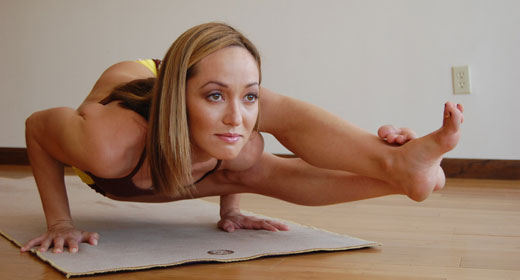by Kino MacGregor: I was a self-taught yogi. After I joined my first yoga class at 19 I bought books on yoga and started doing it on my own at home.

I experimented with the postures, meditation techniques and breathing exercises that I read about in books. This was before the plethora of yoga videos was readily available on the internet so my self-study in yoga consisted of a bunch of rather disorganized stretches done at odd hours of the day that suited my schedule and level of interest. When I joined my first Ashtanga Yoga class nearly two years later I got a hint of the discipline, dedication and determination required to do this practice. But it was only when I traveled to Mysore, India to meet Sri K. Pattabhi Jois and his grandson R. Sharath Jois that I truly experienced the transformational power of having a teacher on the inner journey of yoga.
When I practice alone in the many months I spend away from India each year, I am often back to self-practice. If something is difficult the option simply to skip it hangs in the air. I know from experience how hard it is go through difficult places in the practice alone and how much easier it is to do this with the help of a teacher. For example, when I practice on my own I have to push myself to work my own backbends but when I am in Mysore, India my teacher R. Sharath Jois comes to work with me every day. There are days in India that if I were at home I would take it easy but on those days my teacher motivates me to surpass my limitations. The results are evident in a just a few weeks of practice. I go deeper with his help than on my best days of self-practice. Practicing with Guruji and Sharath has taught me that I do not always know what is right for myself. I have learned the humility to acknowledge that I do not always know what is best or right for myself. Sometimes my preferences are based on a limited concept of myself and my potential. It’s the role of the teacher to help me break through my limitations and experience a stronger, more powerful presence within.
When you teach yourself how to do something you risk teaching yourself unhealthy technique that would lead at best to flawed results or at worst to injury. While the postures are possible to mimic by watching there is something more subtle that happens when you’re in the presence of a great teacher that goes beyond simply seeing the posture and making the shape of it. It’s as though through some sort of spiritual osmosis the teacher’s spirit infuses you with the divine spark of the lineage of yoga. And when that teacher tells you to do something you would normally fear and you do it, it’s more than just the body that changes. A kind of inner shift in both body and mind responds to the expanded potential that the teacher represents. When you surrender your preferences, your like and dislikes, your fear and your uncertainty you learn how to trust a power higher than yourself.
Not everyone has the good fortune to have a teacher readily available to them. Some people lack the financial resource to attend classes. Others, like me, have a remote teacher that lives far away they visit as often as possible. Beginner students sometimes feel more comfortable trying out yoga for the first time at home following online classes or DVDs outside of the intimidating environment of yoga centers. Still many yoga students find yoga accessible online, through books and on social media but have not found one teacher or style of yoga that inspires them to commit and delve deeper. It takes discipline, introspection and dedication to practice alone without direct guidance. Just claiming the space to practice at home amidst our busy lives requires a certain amount of mental fortitude. I was lucky in that I met my teachers within the first year of practicing Ashtanga Yoga. Yes, I traveled to India to meet them, but it was my good fortune to get in touch with this powerful lineage right from the start. I actually attribute the depth of my practice to my early meeting with my teachers. It was Guruji and Sharath who saw the greatness in me and used this practice to bring it out. I know definitively that I could not have done it all on my own.
I’ve noticed the label “self-taught yoga” appearing on social media profiles lately. Since I have both experiences of practicing on my own and studying with a teacher I know just how magical and perhaps important the right teacher can be to the student’s journey. I wonder what this label “self-taught yoga” really means and why people would associate themselves with it, especially those who are teaching. In my journey the first qualification of a good teacher is that they themselves are a student. If we are not willing to be teachable and be guided ourselves how can we expect to guide others? Or is it just the label “self-taught” that is a little out of alignment with the heart of the do-it-yourself yogis?
There will always be people who reinvent the tradition with some new revolutionary way of doing things. There will be prodigies who can figure things out for themselves and break the mold. But even the most experimental artists, such as Salvador Dali, learned the basics as a foundation. Perhaps the self-taught yoga label is a kind of individualism that seeks to redefine what it means to practice yoga in our contemporary era? Perhaps I’m being conservative, but to me the inner path of yoga is like an operation of the body and mind. Outside of the world of yoga it would be rather unacceptable to be self-taught. Would you feel safe in the hands of self-taught neurosurgeon who had watched videos and read books but never went to medical school?
No matter how nightly or humble the origins of your journey, where you have received your training or who has been your guide, you don’t take anything away from yourself by acknowledging the people that have helped you along the way and where you come from. When an Olympic Gold medalist gives thanks to their coaches and teammates they are not taking anything away from their individual accomplishments. The greatest teachers and coaches can only do so much. It is always the student’s effort that makes the journey a success. When you practice every day you are doing the work of yoga and you are the one who is ultimately responsible for your progress. The best teachers are there to make your journey a little faster and perhaps help you avoid unnecessary roadblocks, injuries or pain. Perhaps another way of thinking about the role of the teacher is kind of like the “maps” app on your phone. You can find the way without consulting the GPS but it’s much easier if you have a navigation system that will take you there. Sharing what style of yoga you study, where you practice or what teacher you have been most inspired by is a little bit like telling people what GPS system you use. You don’t detract from the effort that you put into the journey by saying that you had a guide. I wonder if there a latent sense of pride or insecurity in the self-taught yoga label? Contained within the notion of being self-taught may be the notion you are so good that did not need a teacher. Or on the flip side it might indicate that you are not proud of whatever training you did do so you would rather not associate yourself with it. Regardless of the origin of the moniker, sincere spiritual seekers, especially those who aspire to become teachers themselves, will eventually find their way along the path. I have faith that when the student is ready the teacher will appear. It was my yearning to live a more peaceful life that lead me to dedicate myself to Ashtanga Yoga and ultimately it was my desire that for help that carried me all the way to Mysore to meet Guruji and Sharath.
Yoga is spiritual investigation that leads to the center of the true self. It is the chance for each person who practices to be the hero of their own life story by discovering their highest potential. The heroes in all the greatest epics of human history have always had teachers and guides. For example, Luke Skywalker in Stars Wars had Yoda and Froto in the Lord of the Rings Trilogy had countless guides. Everyone knows that it was their hard work and dedication that made their hero’s quest successful. But perhaps the first true test of the hero’s journey is whether the hero is willing to ask directions when they come to a pivotal turning point in their quest. If the students of yoga are to be the teachers of tomorrow they must become the heroes of their own inner journey. It is my hope that each student of yoga finds a true guide along the arduous path of the inner tradition of yoga.














































